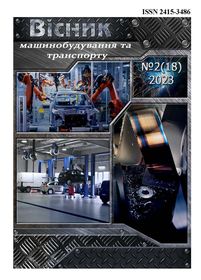Resource assessment of friction surfaces of the brake disc mechanisms by relative wear indicators for cars
DOI:
https://doi.org/10.31649/2413-4503-2023-18-2-120-126Keywords:
car, brake mechanism, friction surface, wear.Abstract
Modern development of vehicle designs requires paying great attention to braking properties, which will depend on the design parameters of the brake mechanisms. The article discusses a scheme where a disc brake is installed on the front wheels, and drum brakes are installed on the rear wheels. From the diagram of the distribution of forces that act on the vehicle during braking, the maximum friction forces for the front and rear axles were determined. A general formula was obtained for the braking distance of a vehicle, during which wear of the brake mechanism occurs. We used the results of the well-known theory of friction and wear by I.V. Kragelsky. The mathematical wear model was built for each friction pair. The wear model takes into account the design parameters of the vehicle, the wear resistance coefficient of materials, the initial braking speed of the vehicle, the mileage and braking distance. The main design parameters of the brake system are the friction radius, the kinematic rolling radius of the wheel, and the amount of drive pressure.
To assess the service life of the brake mechanism, it was proposed to use such an indicator as the relative wear of associated parts. A formula has been obtained for calculating this indicator based on changes in geometric parameters and operating modes of the brake mechanism under operating conditions. A forecast was made of the service life of the brake mechanisms of the front and rear axles of passenger cars, which is proposed to be carried out according to the indicator of relative wear of friction surfaces. Graphic dependences of the distribution of relative wear of the friction surfaces of brake mechanisms for Chevrolet Aveo and Forza cars were constructed. It was shown using the example of Chevrolet Aveo passenger cars that the relative wear of the front axle brakes is maximum and it varies from 22.5 to 26.1%, and for the rear axle this figure varies from 21.0 to 22.5%. The service life of the brake disc is 4.44 times greater than the service life of the friction lining for the Chevrolet Aveo. For the Forza car this figure is 4.76. The results of the work can be used to estimate the residual life of brake mechanisms, taking into account operating conditions.
References
Ярещенко Н. Довгострокове прогнозування швидкостей руху на автомобільних дорогах: автореф. дис. на здобуття наук. ступеня канд. техн. наук: спец. 05.22.11. Харків, 1999.
ДСТУ UN/ECER 13-09-2002. Єдині технічні приписи щодо офіційного затвердження дорожніх транспортних засобів категорій M, N, і O стосовно гальмування (Правила ЕЭК ООН N 13-09:2000, ІDT). [Чинний від 01.07.2005].
ДСТУ 3649: 2010. Колісні транспортні засоби. Вимоги щодо безпечності технічного стану та методи контролювання (БЗ №11-12-2010/436). [Чинний від 28.11.2010]. Київ: Держспоживстандарт України, 2011. 26 с.
Конструктивна зносостійкість вузлів тертя гідромашин. Ч. 2. Методологія моделювання межового змащування в гідромашинах: монографія / В. А. Войтов. Харків: Центр Леся Курбаса, 1997. 152 с.
Назаров О. І., Шпінда Є. М. Потенційна можливість реалізації прирощення вповільнення легковими автомобілями під час екстреного гальмування в різних експлуатаційних умовах. Наукові нотатки: міжвуз. зб. наук. праць. Луцьк, 2019. № 64. С 81–86.
Braking force dynamic coordinated control for hybrid electric vehicles / M. Shang, L. Chu, J. Guo, Y. Fang et al. Proceedings of the 2nd IEEE International Conference on Advanced Computer Control (ICACC '10). Shenyang, China, 2010. Vol. 4. Р. 411–416.
Назаров О. І., Кривошапов С. І., Сергієнко М. Є. Оцінка відносного зносу фрикційних поверхонь дискових гальмівних механізмів легкових автомобілів. Вісник національного технічного університету «ХПІ». Сер.: Автомобіле- та тракторобудування. Харків^ НТУ «ХПІ», 2022. № 1. С. 26–35.
Downloads
-
PDF (Українська)
Downloads: 160



